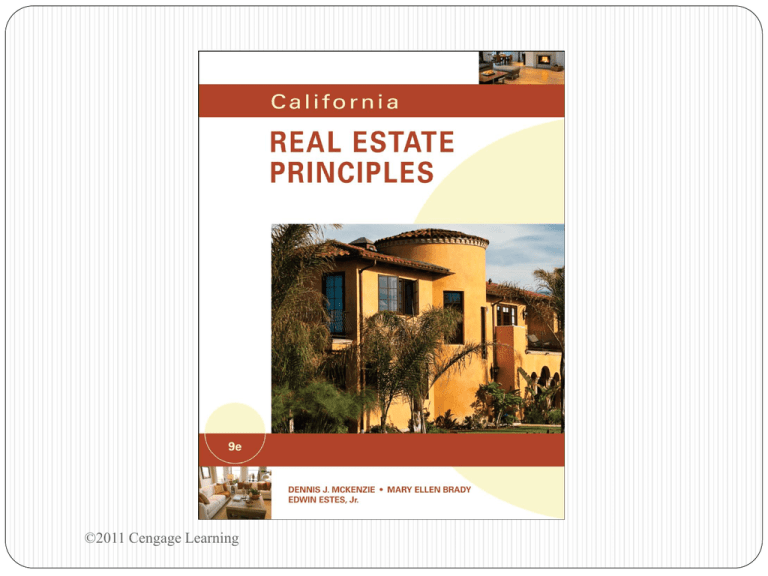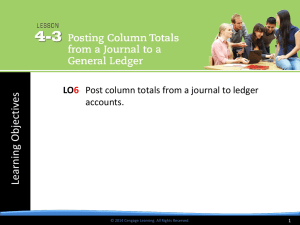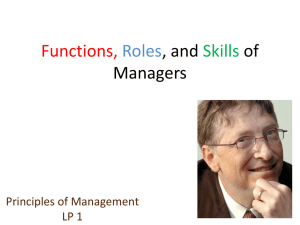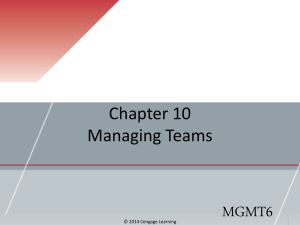PowerPoint for Chapter 13
advertisement

©2011 Cengage Learning California Real Estate Principles Chapter 13 Introduction to Taxation ©2011 Cengage Learning Ch 13 Describe the real property assessment procedure as required by Proposition 13. List the rules regarding the date and manner of payment of real property taxes; describe the tax sale procedure in the event of nonpayment of property taxes. Explain homeowners, veteran's, and senior citizen's property tax exemptions. List the income tax advantages of real estate ownership, including the changes due to recent revisions in the tax laws. ©2011 Cengage Learning Ad Valorem “According to Value” Real Property Taxes House Motor Home Boat Apartment building Personal Property Taxes Sales Tax License Fee Use Tax Transfer Tax ©2011 Cengage Learning Real Property Taxes Assessed at full cash value General (Ad Valorem) Taxes 1. For general support of government 2. Levied against all taxable real property 3. Recur annually ©2011 Cengage Learning Special Assessment Taxes 1. For specific purpose 2. Levied only against properties benefited 3. One-time tax Proposition 13 Change of ownership form required to tax office Cash value x 1% = Annual property tax + local taxes Example: $200,000 lot x 1% = $2,000 Annual property tax x 2% per year = next year’s tax Example: Year 1 $200,000 x 1% = $2,000 2 $2,000 x 102% = $2,040 3 $2,040 x 102% = $2,080 4 $2,080 x 102% = $2,122.42 5 $2,122.42 x 102% = $2,164.87 ©2011 Cengage Learning PROPOSITION 13 Full Cash Value = $500,000 X 1% + local % = x 1.25% Property Tax = $6,250 Ownership since March 1975 3/75 value + per yr. Max= present value x 1% + local % present tax Upon ownership change Current price paid (full cash value) X 1% + local % Present tax New additions only taxed at current value on new construction, not the entire property. ©2011 Cengage Learning No Tax Change Between spouses First $1 million of real property from parents to their children ©2011 Cengage Learning Propositions 60 & 90 Homeowners age 55 years and over Allows the transfer of their low, existing property tax base to another home of equal or lower value Proposition 60: in the same county. Proposition 90: to another California county Only if that county's board of supervisors agrees. ©2011 Cengage Learning Real Property Tax Year Fiscal Year Jan Jul Sep Nov Dec Feb Apr Jun 1 1 1 1 10 1 10 30 Jan 1 – Becomes a lien on the property - File tax exemptions prior July 1 - Fiscal tax year begins Sept 1 - Tax rate determined Nov 1 - 1st installment due (Jul 1 – Dec 31) Dec 10 - 1st installment delinquent Feb 1 - 2nd installment due (Jan 1 – Jun 30) Apr 10 - 2nd installment delinquent Jun 30 - Fiscal tax year ends ©2011 Cengage Learning Tax Sale A 10% penalty added to each late installment June 8 delinquent tax list published June 30 property “Sold” to state Five-year redemption period Un-redeemed property deeded to state Tax collector publishes notice of intent to sell Public auction tax sale Controller’s tax deed ©2011 Cengage Learning Real Property Tax Exemptions 1. California Homeowner’s Exemption $7,000 Reduces property tax ($7000 x 1% = $70) Owner as of January 1-File by February 15 2. Veteran’s Exemption $4,000 3. Property tax postponement law senior citizens (age 62 or older) B. blind or disabled A. 4. California Renter’s Relief Credit against state income tax liability ©2011 Cengage Learning HOMEOWNER’S EXEMPTION Owner occupied by January 1 and filed by February 15 $7,000 off full cash value $500,000 full cash value -7,000 homeowner’s exempt $493,000 taxable value Saves approx. $70 ($7,000 x 1%) ©2011 Cengage Learning Special Assessments Liens Tax liens and assessments have priority over all other liens. Street Improvement Act of 1911 Assessments noted on tax bill For streets, sidewalks, lighting, water, sewer or benefit the owners directly such as for neighborhood parks, schools, and fire stations. ©2011 Cengage Learning Mello-Roos Community Facilities Act of 1982 Failure to disclose allows buyer a 3-day right of rescission, and may result in disciplinary action for the licensed agent Municipal bonds Skirts around property tax limitations of Prop 13 Boom for developers Broker must disclose to prospective purchaser May not be fully tax deductible ©2011 Cengage Learning INCOME TAXATION State and federal income tax A progressive tax Agents: Recommend tax counsel Tax consequences may be a material fact Need good record keeping on property ©2011 Cengage Learning PERSONAL RESIDENCE Interest Deduction Major Tax Advantages for Homeowners: ©2011 Cengage Learning 1. Subject to a $1 million dollar limitation 2. The interest on money borrowed to purchase a first and second home is fully deductible against the homeowner’s income 3. A homeowner may also borrow against the equity up to $100,000 and still deduct the interest as homeowner interest No taxable gain recognized on Residence Homeowners may claim an exception from taxation on profit from the sale of their personal residence up to a maximum amount of $250,000 for singles, up to $500,000 for married couples. Homeowner must have owned & resided in home 2 of last 5 yrs. Can take the deduction every 2 years. May not deduct depreciation, maintenance or operation expenses. Any gains above these amounts are taxed at the current capital gain tax rate. ©2011 Cengage Learning Installment sale Sale with down payment & loan. Tax is due as loan is repaid over term. ©2011 Cengage Learning Income Property Annual Deduction Operating Expenses T Taxes (Property) I Insurance M Maintenance M Management U Utilities R Reserves for Replacement Depreciation 27 ½ years for residential income property 39 years for non-residential income property ©2011 Cengage Learning Investment property Vacant land (unimproved property) ©2011 Cengage Learning Trade or Business Property Owner derives major source of livelihood from the property ©2011 Cengage Learning 1031 Tax–Deferred Exchanges 1. 2. 3. 4. Pay no taxes at time of equal exchange The new property must be “like for like” kind Any “boot” (cash) received is taxable The exchange may be simultaneous or delayed. If delayed there are rigid timetables and the exchange is frequently called a “Starker” exchange. + $25,000 cash Value $200,000 Basis 100,000 Mortgage 50,000 ©2011 Cengage Learning Value $300,000 Basis 150,000 Mortgage 75,000 Non-personal residence Exchange – IRC 1031 Decreases basis on new property by the gain deferred on old property Tax liability is not forgiven - Defers (postpones) tax due, NOT tax “free” Close of escrow date rules: Close concurrent Delayed – accommodator 45 days to name the new property 180 days (6 months) to close the escrow Mortgage relief (Boot) ©2011 Cengage Learning Registered Domestic Partners RDP cannot file joint income tax returns for either state or federal taxes. ©2011 Cengage Learning Review Quiz Chapter 13 1. The homeowner’s exemption, excluding local assessments, saves approximately how much in property taxes? a. $100 b. $80 c. $70 d. $40 ©2011 Cengage Learning Review Quiz Chapter 13 2. The proposition that allows certain homeowners to transfer their property tax base to another home in the same county is: a. Proposition 13 b. Proposition 57 c. Proposition 60 d. Proposition 90 3. The second installment of real property taxes is delinquent if not paid by: a. November 1 b. December 10 c. February 1 d. April 10 ©2011 Cengage Learning Review Quiz Chapter 13 4. Which of the following is true? a. A person cannot use a homeowner’s exemption and a veteran’s exemption on the same home b. Real property taxes become a lien on the first Monday in March c. A 12% penalty is added for delinquent property taxes d. California has special property tax exemptions for senior citizens 45 years or older ©2011 Cengage Learning Review Quiz Chapter 13 5. A property was valued at $500,000 for property tax purposes. According to Proposition 13, what would be the maximum value for property tax purposes in two years, assuming the owner did not make capital improvements? a. $502,420 b. $504,010 c. $506,220 d. $520,200 ©2011 Cengage Learning Review Quiz Chapter 13 6. To obtain a full homeowner’s exemption, a new homeowner must file between January 1 and: a. December 10 b. February 15 c. April 10 d. June 1 ©2011 Cengage Learning Review Quiz Chapter 13 7. When foreigners sell U.S. property the Foreign Investment in Real Property Tax Act (FIRPTA) may require what percentage be withheld from the sale proceeds? a. 3-1/3% b. 5% c. 10% d. 13% ©2011 Cengage Learning Review Quiz Chapter 13 8. When a special assessment is made on a piece of property under the Street Improvement Act of 1911: a. Property owner can deduct principal and interest b. It is based on the front footage of the property c. It is appraised as per the amount of square footage d. Assessment must be paid within six months 9. Under certain conditions, a single home owner may except up to how much in tax free gains from the sale of a their personal home? a. $500,000 b. $300,000 c. $250,000 d. $125,000 ©2011 Cengage Learning Review Quiz Chapter 13 10. An investor who has owned a property for 2 years and then sells for a gain most likely will pay: a. Capital gains taxes b. Ordinary income taxes c. Only California, not federal taxes d. Not pay taxes as a sale for cash qualifies as a 1031 exchange ©2011 Cengage Learning Answers to Review Quiz Chapter 13 1. C 6. B 2. C 7. C 3. D 8. B 4. A 9. C 5. D 10. A ©2011 Cengage Learning








